This year, Black Friday will take place on November, 27th and I would like to explain why you must start to work on it now to outrank your competitors in November.
As most of you are aware, this is one of the most important dates of the year, especially for E-commerce websites. Sales are higher than during the Christmas period because consumers tend to anticipate their purchases to take advantage of the bargains companies offer for their products.
With the E-commerce adoption on the rise in all countries due to the Covid-19 pandemic, this Black Friday will be fascinating to follow. Will new players disrupt some industries where traditional E-commerce brands get the majority of the traffic during this period? We don’t know yet, but whether you launched your E-commerce some weeks ago or if you are a big established brand, you must think about Black Friday now! More than ever, you need to plan your strategy ahead.
Before jumping into the explanation, one comment: the same exact strategy can be applied for the Cyber Monday or SIngle’s Day. I don’t mention them, but the logic is exactly the same !
Why should you care about Black Friday?
If you go to Google Trends to have a look at the popularity of the query “Black Friday”, you can clearly see that it is on the rise over time.

You can pick whatever country you want, the trend will be similar. I’m living in Spain so I investigated what occurred here last year and I found this interesting study (in Spanish) providing great insights on how customers behave. The key takeaways are the following:
- The share of persons buying something during the Black Friday campaign is on the rise
- Half of these purchases are done online
I think you understand the point I’m trying to make: you can’t ignore the fact that your customers will be looking to buy, mostly online, even if the importance of this channel can vary depending on the industry you are in. If you don’t have a strategy to get their attention, you will be missing out big time!
What can you do now?
What can you do right now to try to get a piece of that cake? First of all, and as you should always do if you work on your SEO, you should understand your market. Which means: what kind of queries should you target?
Keyword Research
Let’s start with the most obvious one: the query “black Friday”. You can try to go after it only if you are working for:
- A big and generic E-commerce brand like Amazon
- A media like CNN
- A website highly specialized on Black Friday
Why? First of all, because Google displays news during this period. This is a concrete application of the Query Deserves Freshness algorithm that we all saw in action during the Covid-19 pandemic where you would search for any country name and have COVID-related news at the top of the SERPs.
Just look at the results in the US for the query “black Friday” and how it changed in less than a month: the news carousel appeared and few websites remained in the same position. Some went down the page, others just disappeared.
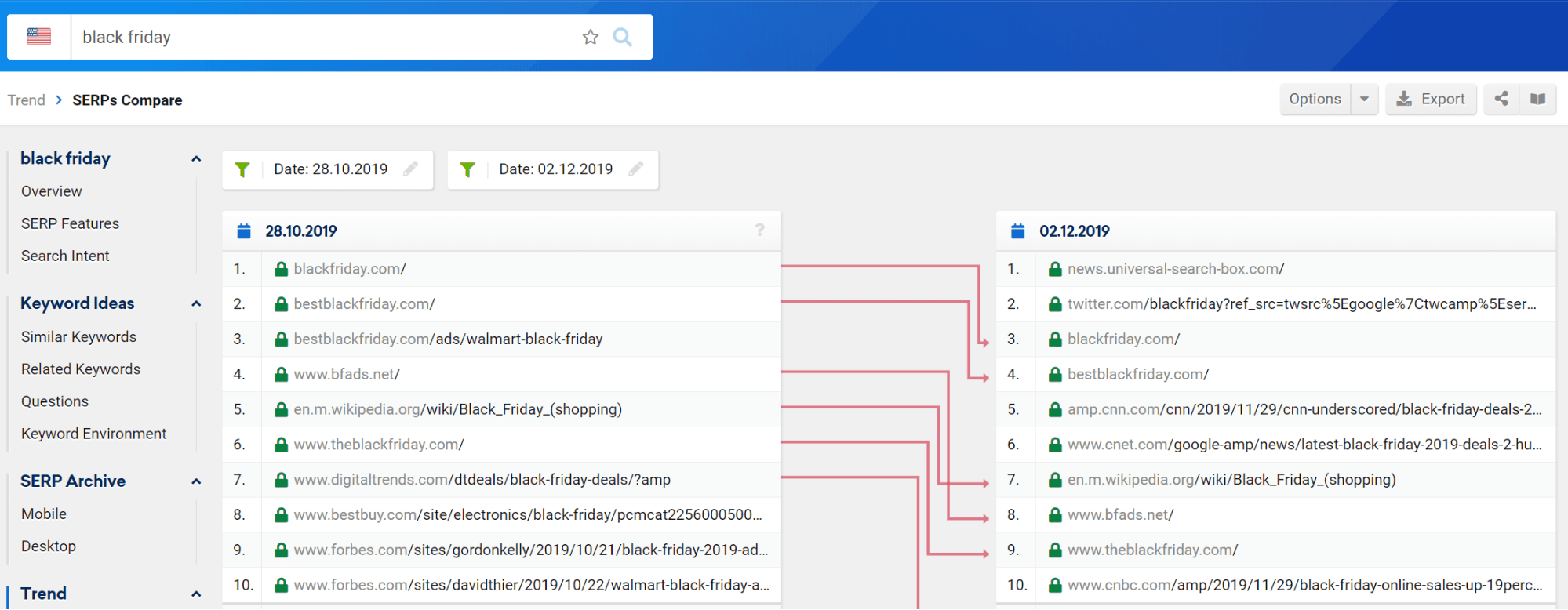
Therefore, what’s even the point to try to rank on this query if you are going to get removed from the first page when search volumes increase?
The situation is less dramatic in other markets like Spain where some major E-commerce brands like Amazon, PcComponentes, and Fnac remain on the first page. Investigate to see if you can target this query, but I often advise to just ignore it.
What you need to do is find keywords linked to “black Friday” that your customers are looking for. It is easy: just add “black Friday” after/before your product name and retrieve the volume.
One example:
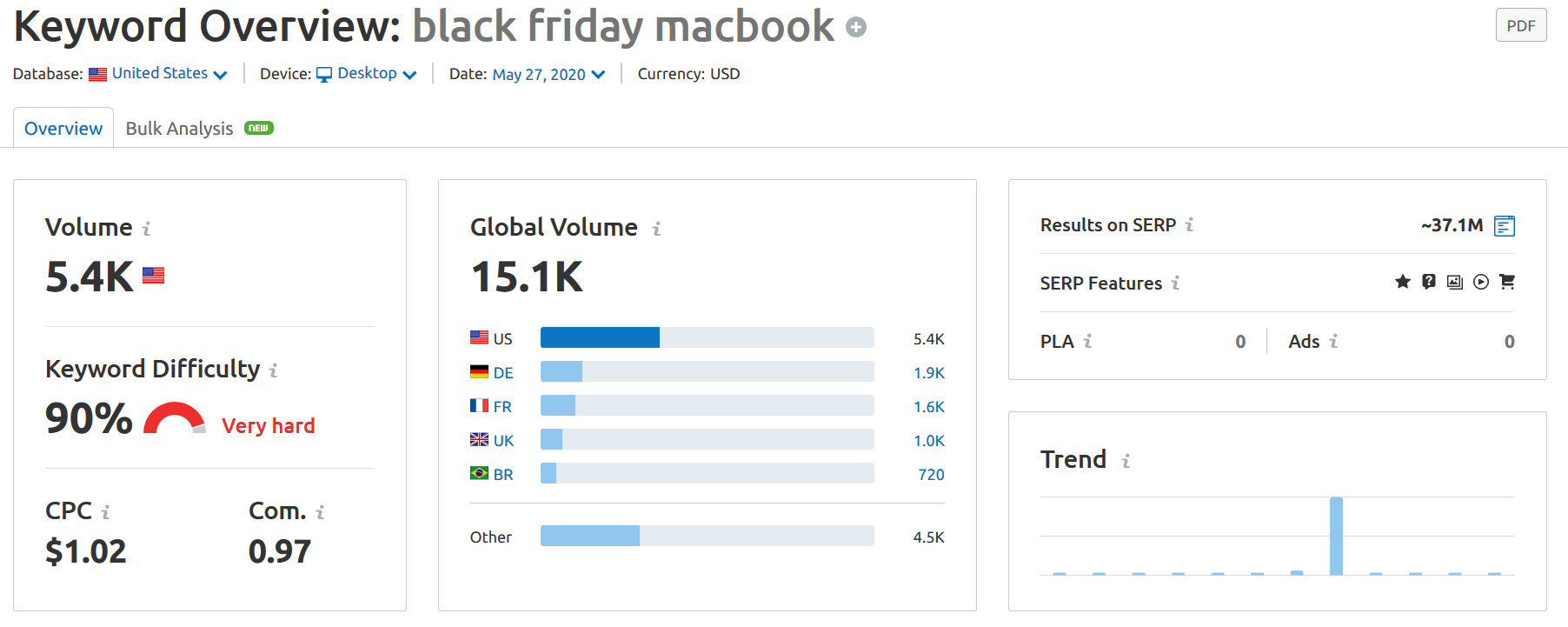
Pay close attention to the trend: you obviously have a peak in November, so the real search volume in November will be closer to 50.000 and not 5.400 as reported by SEMRUSH. Pretty nice right?
If you don’t know which seed keywords you should start with, several tips:
Spy on your competition
One quick way to find good keywords is to look at your competition. Let’s use SEMRUSH for this part, but you can use Ahrefs or Sistrix to do exactly the same.
- Identify your competitors’ URLs targeting Black Friday related keywords. Just go to SEMRUSH and type one domain in the search bar. In my case, I will use fnac.es

- Go to Domain Analytics > Organic Research > Pages and activate the following filter

You can obviously tweak it a little bit but it usually the best one. You now have at least a part of the keywords you could compete on by extracting the keyword report for these URLs.
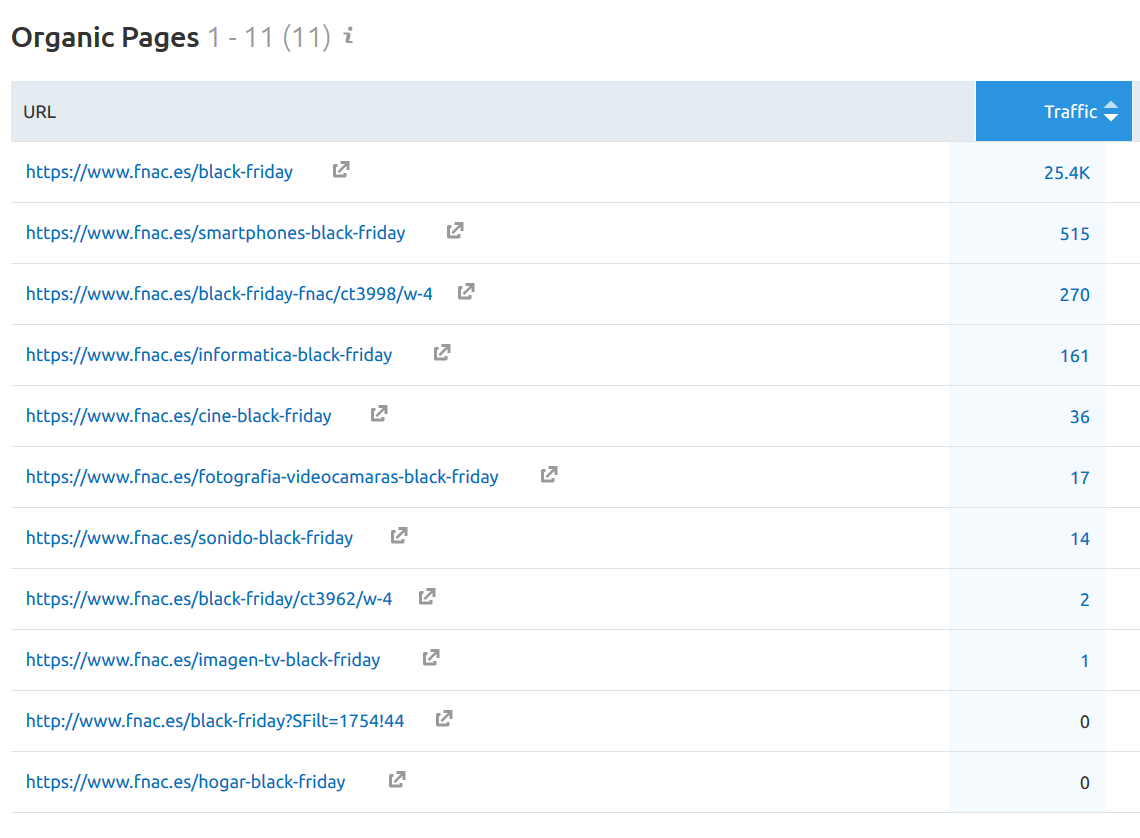
Use your data
Another option is to use your Google Search Console data. Let me explain again what you need to do:
- Go to Search Console and open the query report (Performance > Search Results > Queries tab)
- Exclude your blog because you usually want to target transactional queries only. This is a general rule, in some cases, I do understand that there may be interesting black Friday informational queries.
- Export the top keywords using the Export button
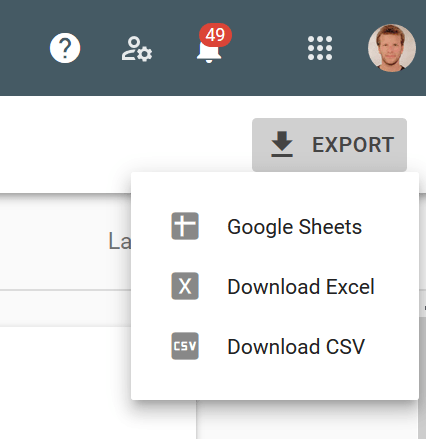
- Using the CONCAT function, add “black Friday” before or after your queries.
- Retrieve search volumes using an API. You can read this post I wrote some weeks ago to do so. It is in French but the last part, which explains how to create a custom Sheets formula to retrieve volume using the SEMRUSH API, can be easily followed if you translate it in English. You will be retrieving average monthly volume, don’t forget to multiply it by 10-12 to have the search volume in November only.
This approach assumes that you have enough data in Search Console to do it, so it is not perfect but you can discover new keywords using this method.
At this point, you should have a list of keywords, with their associated search volume in November that you want to target with specific landing pages.
Don’t forget to share this report with your PPC team, because they will need to run campaigns on these keywords as well.
Define the architecture
Let me explain more in-depth why I advise you to start your page creation process right now. As mentioned in the introduction, Black Friday can be the most important day during the year. But at the same time, you can’t expect to rank on “black Friday MacBook” in 1 week because the competition is fierce.
I had a client, when I was working at SEOCOM, whose first Black Friday campaign was launched less than a month before and the results were obviously very disappointing because we didn’t have the time to rank. The next year? Our Black Friday pages generated more traffic than the homepage itself. Huge success!
So, with your keyword research, create a mini-architecture for your Black Friday section. It’s up to you to define if you can target all your terms with only one page or more than one. It really depends on your sector.
If you are working in the laptop industry, a part of your architecture could be the following:
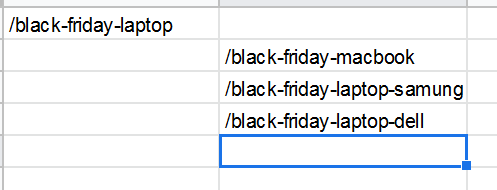
I’d rather not include the year in the URL to avoid useless redirections over time, but I’ve seen competitors including them and doing just fine, so it’s up to you.
Create the content
For these pages, you need to include a bit of content, otherwise, they won’t rank. What can you write about?
- Details about the Black Friday (origin & date for instance)
- Explanation of the deals you will have
It is very important not to optimize too much on the product name itself because we don’t want the black Friday page to outrank the category pages on queries like “dell laptop”. Not very likely, but keep that in mind.
I know that we usually try not to write only for the algorithm, but let’s be honest: that’s what you will do here. Try to add genuinely interesting information but very few will actually read it. If you are not sure what to include, just search for your queries on Google and take a look at what your competitors included.
Creating this kind of content is a little bit spammy but it works. Look at this example where we managed to get to the first page in a matter of days. Why? Good content and low competition even if the keyword is searched more than 30.000 times in November. Easy win and we still have several months to get to the first place which is our objective for this query!

Don’t forget to add a mail form as well at the top of everything, because you will have traffic before the Black Friday on this page if it ranks (traffic starts to appear several weeks before because people are starting to investigate). You can’t sell them anything at the moment but if they leave you their Email addresses, they are more likely to buy from you.
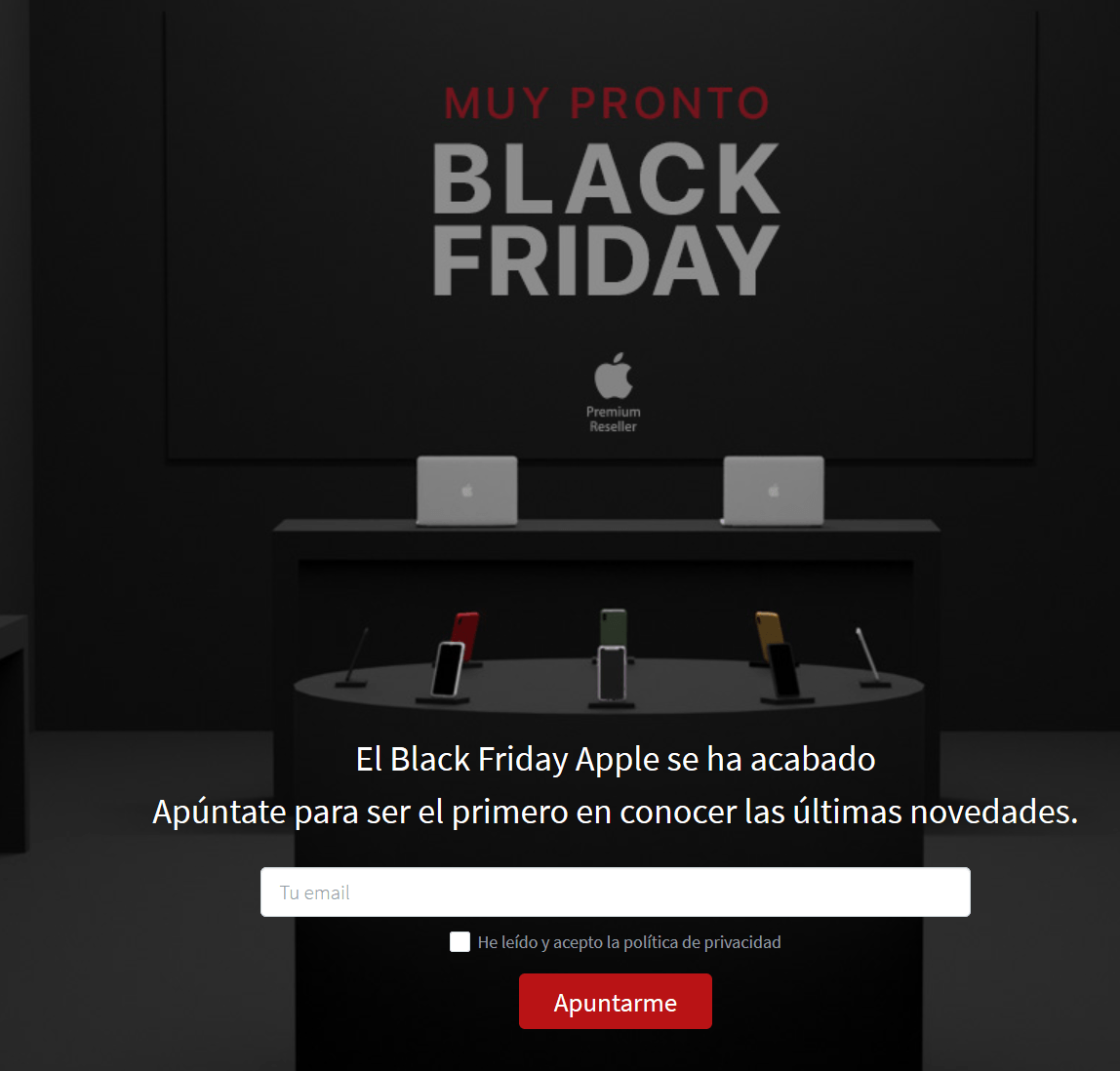
Internal linking
At this point, you obviously don’t want to link your Black Friday pages from your main navigation because it would make no sense. Nevertheless, think about including it in your footer. Why? Because we are trying to rank some pages that can generate more traffic than your brand in November, you need to help them get where you want them to be, and you can leverage the footer to do just that. Even if all links are not treated equally by Google, it can make the difference with your competition to outrank them on key queries.
Don’t forget to link your pages between themselves as well.
Internal linkings is sometimes an overlooked way of making your way up to Google’s top position, so my advice is to go for it!
Publish and track results
That’s it for now, just publish the pages and wait. Just check rankings (not traffic, you won’t have) once in a while and improve your content if you need to. The objective is to get to the first page as soon as possible when the competition is still low.
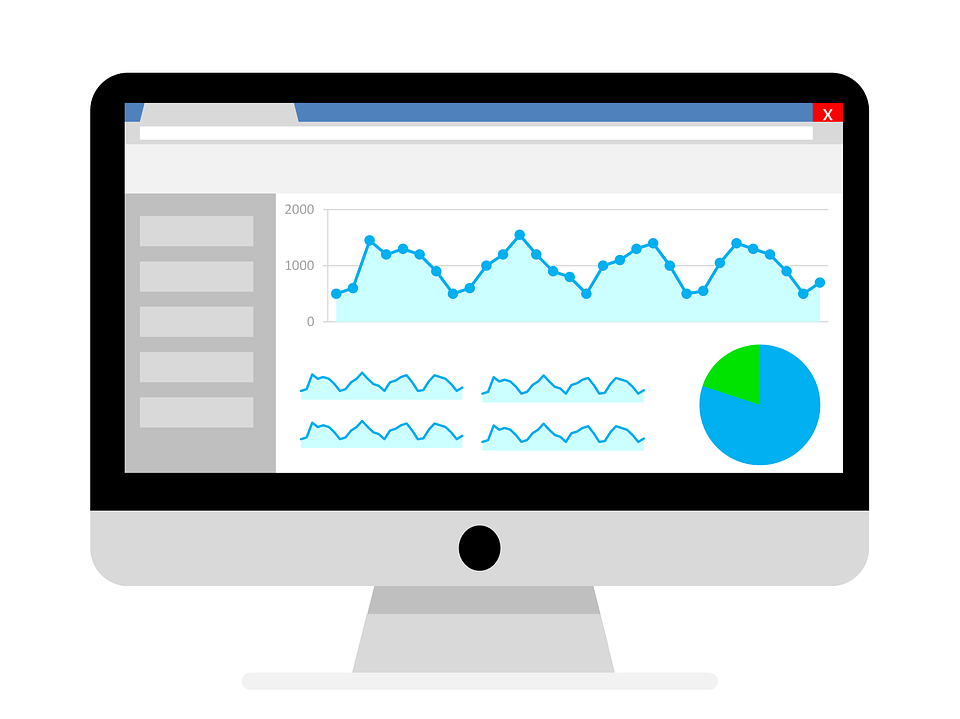
You can configure a ranking tracking project with the keywords you optimize your content for, it is definitely worth it! You have a lot of tools out there and you can even build it directly in Google Sheets, so you have no excuse to skip this part.
What can we do some weeks before Black Friday?
Let’s imagine that you managed to get your pages to rank on the first page for your main queries. This is great, but as you may have guessed, this is not enough. Indeed, you will be able to attract visitors looking for a specific product, but what about customers that are looking for the best deals to choose what to buy? And what about customers that don’t use Google?
I stated at the beginning that during Black Friday, Google tended to rank media websites for the query “black Friday”. Contents like https://www.techradar.com/news/black-friday-deals-2019 get instantaneous visibility. Moreover, this is the kind of content they will push to their audience through social media, email, etc… because they know they are looking for this kind of information during this period. What if you could make your way to this list? Two ways:
- Organically if your deals are super good or if you are a well-known brand
- Through a payment or an affiliate program which is, to be honest, the easiest way to get there if you are not that well-known. Target websites where you know that your audience is!
In both cases, try to make these sites link to your main Black Friday pages because it will help them rank for the next campaign!
By closing these deals as soon as possible you will have hopefully your brand present wherever it needs to be.
During the Black Friday
Here we are, the Black Friday is finally here. You still have some things to do. I won’t state that you need to highlight the best deals on your Homepage, reach your audience with your best deals through emailing, etc… because it is pretty obvious and is not directly linked to SEO.
- Optimize your meta description or meta title
At the end of the day, a lot of users are not even including “Black Friday” in their queries because they assume you will have something to offer. But make it clear in your Meta Description, that should be updated some days before to make sure Google has time to update its index.

- Update your Black Friday pages
Replace the mail form you had since their creation by a list of your best deals. Think about the user intent: if I look for “black Friday MacBook” during Black Friday, I actually want to buy one. Show me products, don’t show me a form.
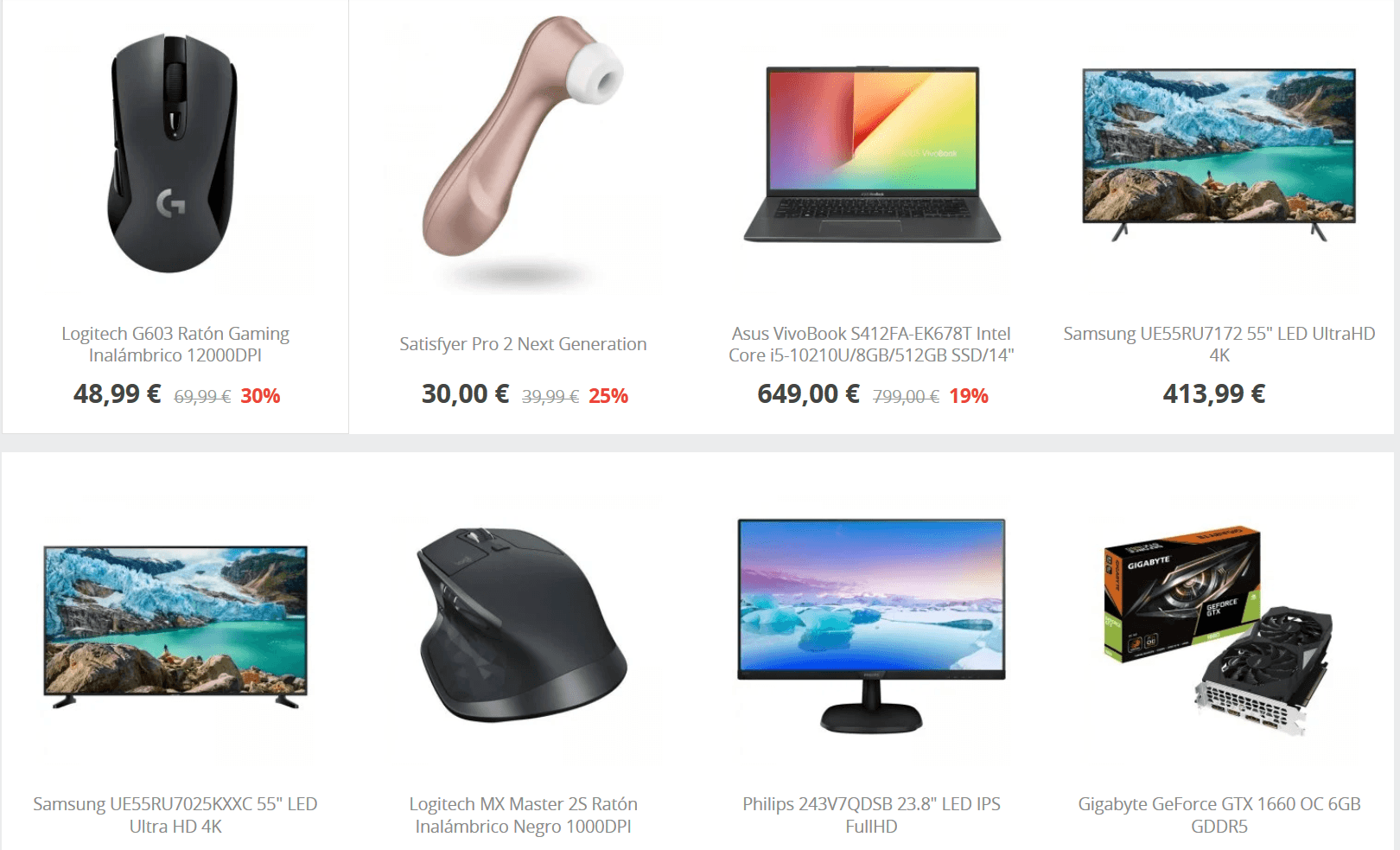
This update must be scheduled before the Black Friday and activated once your promotions go live on your website.
- Track noindex
I’ve seen so many websites adding noindex to their pages during the Black Friday, simply because they had it in the development environment, pushed it to live environment but forgot to update this part of the code. Please watch this carefully or invest in a monitoring tool like ContentKing or Little Warden to have your back.
You can ruin months of hard work by making this mistake, so even if you think you don’t need these tools throughout the year, just invest in one of them in November.
After the campaign
I can’t stress this enough: DO NOT DEACTIVATE YOUR PAGES.
You will need them during the next campaigns, so don’t deactivate them. You can remove them from your internal linking if you want, but please don’t throw away months of hard work. No matter if it worked or no, JUST DON’T DO IT.
Apart from this basic advice, you can carry out several tasks:
- Export all the queries including “black Friday” for your Search Console account to add new pages you hadn’t considered in the first place or improve your content for next year
- Look at the revenue generated directly by your landing pages to assess if it can be profitable to launch a link-building campaign on these pages next year to secure your first spot in the SERP.
Final words
When it comes to Black Friday, it is never too early to start working on your strategy. Apart from the fact that you need time to rank, holidays in July-August can slow down implementation, therefore it is always better to plan actions when the team is fully available.
Don’t forget it and explain to your clients or to the Marketing team if you are in-house why you included a Black Friday task in June. It is usually not that hard to convince them because you are talking about real €€€ here.
